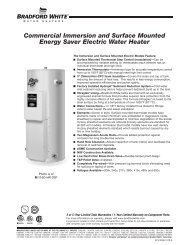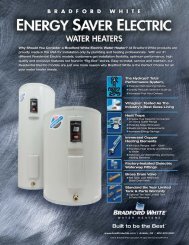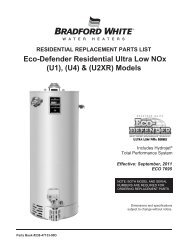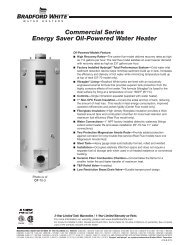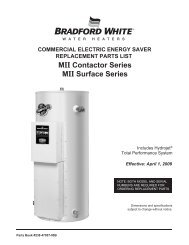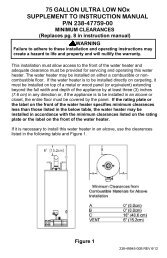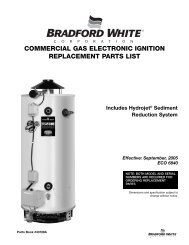238-45085-00B - Bradford White
238-45085-00B - Bradford White
238-45085-00B - Bradford White
- No tags were found...
Create successful ePaper yourself
Turn your PDF publications into a flip-book with our unique Google optimized e-Paper software.
Maintenance continued-To inspect or replace an anode:The anodes on this water heater are easily accessible from the top ofthe heater making replacement simple and quick.a. Turn the water heater electricity off for the zone containingthe indirect-fired water heater. Flow water until thedischarge is cool or allow enough time for the potable waterto cool naturally. Connect a hose to the drain valve. Locatethe hose’s discharge in an area where any remaining hotwater will not cause any damage or injury.b. Open the drain valve to flush any sediment out of thebottom to the heater.c. Shut off the cold water supply. Make sure all hot waterfixtures and circulating pumps are turned off.d. Wait for water flow from the hose to stop. Remove theanode using a socket of the appropriate size. Do not use animpact wrench.e. Inspect and replace the anode as required. Use pipe tape orsealant when reinstalling the anode.f. Close the drain valve. Open a hot water fixture to allow airto escape. Open the cold water supply to the heater andallow the tank to fill.g. Check your anode and drain valve for leaks.h. Turn the water heater electricity on for the zone containingthe indirect-fired water heater.4. Sediment (Annual, but harsh water quality may dictate morefrequent service)- Depending on water conditions, a varyingamount of sediment may collect in the tank. Levels requiringservice are indicated by a small temperature difference in thesupply and return lines (See also “Scale” below). Repeatedflushing usually clears such material. As a preventive measure,water should be drawn from the tank at the drain valve until itruns clear.5. Scale (Annual)- Hard water may cause scale to build-up on theoutside of the heat exchanger coil. A water softener will preventthis problem (See also “Sediment” above). Symptoms would bereduced recovery capacity or reduced temperature differentialbetween boiler supply and return lines. Repeated flushingshould resolve the problem.31



